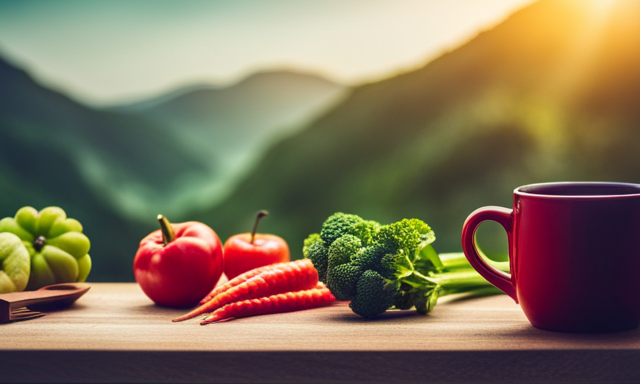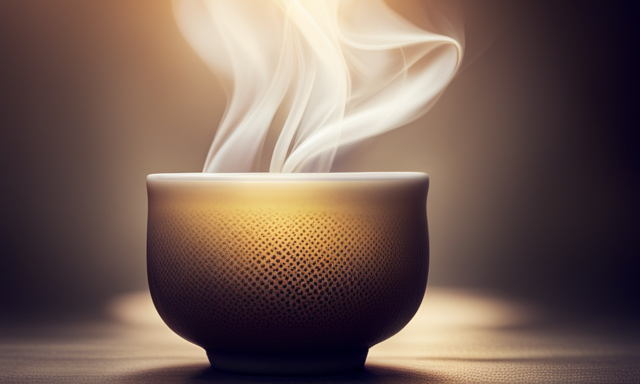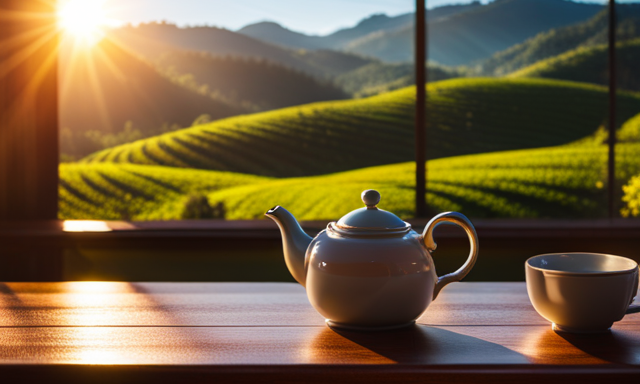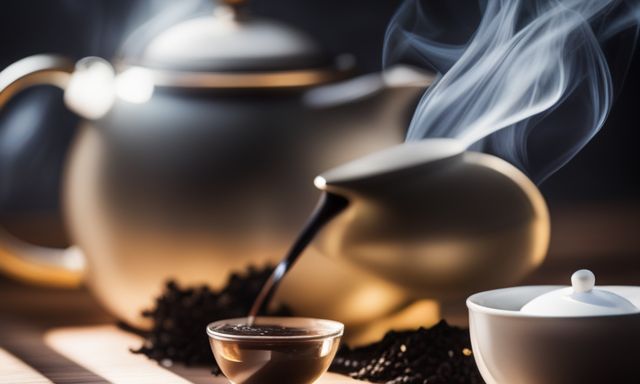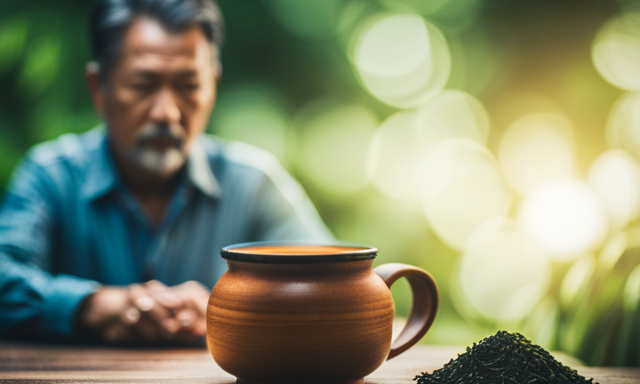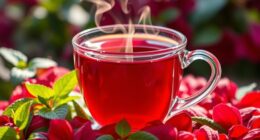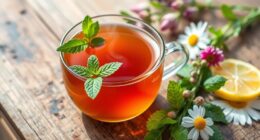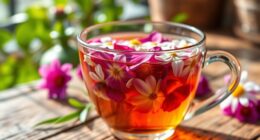I remember the first time I heard about oolong tea being touted as a weight loss aid. It was hard to believe that something as simple as a cup of tea could have such a significant impact on shedding those extra pounds. But as I dug deeper into the research, I discovered that there is indeed some truth to this claim.
Oolong tea, with its unique composition and properties, has been found to possess several qualities that can support weight loss efforts. From boosting metabolism and regulating blood sugar levels to suppressing appetite and enhancing fat oxidation, oolong tea seems to offer a multitude of benefits.
Not only that, but it also provides antioxidant support, improves energy and focus, and even helps balance gut health. Incorporating oolong tea into a healthy lifestyle could be a wise choice for anyone looking to shed those unwanted pounds.
So, let’s explore the science behind why oolong is said to be a weight loss tea.
Key Takeaways
- Oolong tea increases fat metabolism and promotes a healthier weight.
- Oolong tea improves digestion and nutrient absorption.
- Oolong tea promotes growth of beneficial bacteria in the gut for a healthy gut microbiome.
- Oolong tea provides antioxidant support and protects against oxidative stress and inflammation.
Understanding the Composition of Oolong Tea
You may be surprised to learn that oolong tea is packed with powerful components that can help you shed those extra pounds and achieve your weight loss goals.
Oolong tea contains polyphenols, which are antioxidants that have been shown to have numerous health benefits. These antioxidants can help improve heart health by reducing the risk of heart disease and lowering cholesterol levels. Additionally, oolong tea can promote healthy skin by reducing inflammation and preventing skin damage caused by free radicals.
But how does oolong tea help with weight loss? Well, one of the key components in oolong tea is catechins, which have been found to increase metabolism and fat oxidation. By boosting your metabolism, oolong tea can help you burn calories more efficiently and aid in weight loss.
So, if you’re looking to shed those extra pounds, incorporating oolong tea into your daily routine may be a simple and effective way to reach your goals.
Boosting Metabolism with Oolong Tea
Indulge in the aromatic and flavorful beverage that can rev up your metabolism and help you achieve your weight goals. Oolong tea has been found to have properties that can boost metabolism and improve weight loss. How does it work?
-
Oolong tea contains caffeine and catechins, both of which have been shown to increase metabolism and fat oxidation.
-
Studies have also suggested that oolong tea can enhance the body’s ability to burn fat by activating enzymes involved in fat breakdown.
-
Oolong tea has been found to increase energy expenditure, helping you burn more calories throughout the day.
-
This tea may also help regulate blood sugar levels, preventing spikes and crashes that can lead to cravings and overeating.
By boosting metabolism and improving weight loss, oolong tea can be a valuable addition to your weight loss journey.
As we delve into the next section on regulating blood sugar levels, let’s explore how this tea can further support your overall health and wellness.
Regulating Blood Sugar Levels
Discover the powerful benefits of regulating blood sugar levels, allowing your body to maintain a balanced and consistent source of energy throughout the day.
Oolong tea has been shown to play a role in blood sugar management, making it a popular choice for those looking to promote weight loss. Studies have found that drinking oolong tea can help regulate blood sugar levels by improving insulin sensitivity and reducing blood glucose levels.
By keeping blood sugar levels stable, oolong tea can prevent spikes and crashes in energy levels, which can often lead to cravings and overeating. This, in turn, can support weight loss efforts by promoting a more controlled and balanced approach to eating.
Transitioning into the subsequent section about ‘suppressing appetite’, oolong tea’s ability to regulate blood sugar levels may also help curb excessive hunger and cravings.
Suppressing Appetite
Oolong tea has been known to have the ability to reduce hunger pangs, making it a popular choice for those looking to suppress their appetite. As a tea lover myself, I’ve experienced this firsthand. Drinking a cup of oolong tea before a meal helps me feel fuller for longer, which can be helpful in managing portion control and avoiding overeating.
Oolong tea’s ability to reduce hunger pangs
One of the reasons why oolong tea is believed to aid in weight loss is its ability to curb cravings and suppress appetite. Oolong tea’s impact on mood and hydration plays a significant role in reducing hunger pangs.
Here’s a three-item list to illustrate this:
-
Mood enhancement: Oolong tea contains theanine, an amino acid that’s been found to promote relaxation and reduce stress. By improving mood, oolong tea can help curb emotional eating, which often leads to overconsumption of calories.
-
Hydration: Staying hydrated is crucial for weight management. Oolong tea, like other teas, is a hydrating beverage that can help you feel fuller and reduce the tendency to snack unnecessarily.
-
Appetite suppression: Oolong tea contains polyphenols that’ve been shown to reduce hunger pangs. These compounds may affect the secretion of ghrelin, a hormone that stimulates appetite.
By reducing cravings and suppressing appetite, oolong tea can contribute to feeling fuller for longer, aiding in weight loss goals.
Feeling fuller for longer
Feeling satisfied like never before, oolong tea keeps you fueled and content throughout the day. Its ability to control cravings and keep hunger pangs at bay is what makes it a popular choice for weight loss. When you drink oolong tea, it can make you feel fuller for longer periods of time, reducing the urge to snack or overeat. But how does it achieve this? Oolong tea contains polyphenols, which have been found to have anti-obesity effects. These polyphenols help regulate the production of ghrelin, a hormone that stimulates hunger. By controlling ghrelin levels, oolong tea helps you feel satisfied and reduces the likelihood of overeating. This effect, combined with its ability to boost metabolism, makes oolong tea an effective tool for weight loss. Transitioning into the next section, let’s explore how oolong tea enhances fat oxidation.
Enhancing Fat Oxidation
Oolong tea has been shown to play a role in breaking down fat cells and enhancing fat oxidation. Studies have found that compounds in oolong tea activate enzymes that help to break down triglycerides, the main form of fat stored in our bodies. This can increase the body’s ability to use stored fat as energy, making it a potential aid in weight loss efforts.
The role of oolong tea in breaking down fat cells
Imagine how empowering it would be to have a natural beverage that actively aids in the breakdown of fat cells, helping you achieve your weight loss goals. Oolong tea, with its unique combination of polyphenols and caffeine, has been shown to have a significant impact on fat metabolism.
When consumed regularly, oolong tea can help to break down fat cells by boosting metabolism and increasing fat oxidation. Here are two ways that oolong tea supports fat cell breakdown:
- Polyphenols in oolong tea activate enzymes that enhance the breakdown of fat cells.
- Caffeine in oolong tea stimulates the nervous system, increasing the release of stored fat into the bloodstream.
By incorporating oolong tea into your weight loss routine, you can take advantage of its ability to break down fat cells and increase the body’s ability to use stored fat as energy.
Transitioning into the next section, let’s explore how oolong tea can further enhance weight loss by increasing the body’s ability to use stored fat as energy.
Increasing the body’s ability to use stored fat as energy
With its unique properties, oolong tea has the potential to revolutionize the way our bodies utilize stored fat as energy. Oolong tea contains compounds that can increase fat metabolism and promote fat burning, making it an ideal choice for those looking to lose weight. One of the key components in oolong tea is catechins, which have been shown to boost the body’s ability to break down stored fat and use it as fuel. Additionally, oolong tea contains caffeine, which can further enhance fat burning by increasing the body’s metabolic rate. Studies have shown that regularly consuming oolong tea can lead to significant improvements in weight loss and body composition. By incorporating oolong tea into your routine, you can harness its potential to increase fat metabolism and promote a healthier weight. Moving forward, let’s explore how oolong tea can help balance gut health.
Balancing Gut Health
Oolong tea has been shown to have a positive impact on digestion and nutrient absorption. Studies have found that the polyphenols present in oolong tea can help in breaking down fats and carbohydrates more effectively, thereby improving digestion.
Additionally, oolong tea supports a healthy gut microbiome by promoting the growth of beneficial bacteria in the gut, which can contribute to better digestion and overall gut health.
Oolong tea’s impact on digestion and nutrient absorption
To enhance your understanding of oolong tea’s potential for weight loss, consider the impact it has on your digestion and nutrient absorption.
Oolong tea has been found to have a positive effect on nutrient absorption, which plays a crucial role in weight management. The polyphenols present in oolong tea help to stimulate the enzymes responsible for breaking down food and extracting nutrients. This can enhance the efficiency of digestion and ensure that your body is able to absorb the maximum amount of nutrients from the food you consume.
By improving digestion and nutrient absorption, oolong tea can support your overall weight loss goals.
Moving forward, let’s explore how oolong tea can also support a healthy gut microbiome.
Supporting a healthy gut microbiome
After discussing how oolong tea can impact digestion and nutrient absorption, it’s important to highlight its role in supporting a healthy gut microbiome.
The gut microbiome plays a crucial role in our overall health, and maintaining its balance is essential for optimal digestion and nutrient absorption. Oolong tea has been found to have probiotic benefits, which means it can promote the growth of beneficial bacteria in the gut. This is significant because a healthy gut microbiome has been linked to improved mood, cognition, and even weight management through the gut-brain connection.
By supporting a healthy gut microbiome, oolong tea may indirectly contribute to weight loss.
Now, let’s delve into how oolong tea provides antioxidant support.
Providing Antioxidant Support
Boost your weight loss journey with the antioxidant-packed benefits of oolong tea. This delicious beverage has been shown to support weight loss by promoting fat burning in the body.
Oolong tea contains compounds called catechins, which have been found to boost metabolism and increase fat oxidation. These catechins work by activating certain enzymes that help break down stored fat and convert it into energy.
Additionally, oolong tea is rich in polyphenols, which are powerful antioxidants that can help protect the body from oxidative stress and inflammation. By incorporating oolong tea into your daily routine, you can provide your body with the antioxidant support it needs while working towards your weight loss goals.
Transitioning into the next section, oolong tea can also improve energy and focus throughout the day.
Improving Energy and Focus
Increase your energy and focus with the invigorating effects of oolong tea, allowing you to conquer your day with a clear mind and unwavering determination. Oolong tea contains caffeine, which is known to improve mental clarity and increase productivity.
The combination of caffeine and other natural compounds found in oolong tea promotes alertness and enhances cognitive function. This can help you stay focused and productive throughout the day. Studies have shown that oolong tea can also improve attention and reaction time, making it a great choice for those looking to boost their energy levels and mental performance.
By incorporating oolong tea into your daily routine, you can experience improved mental clarity and increased productivity, setting yourself up for success in all areas of life.
Incorporating Oolong Tea into a Healthy Lifestyle
To live a healthy lifestyle, you can easily incorporate the invigorating effects of oolong tea into your daily routine. One way to incorporate oolong tea into your workout routine is by drinking it before or after your exercise session. Oolong tea contains caffeine and catechins, which can help improve energy levels and enhance focus during workouts.
Additionally, oolong tea can be a great replacement for sugary drinks, such as soda or energy drinks, which can contribute to weight gain. By substituting these high-calorie beverages with oolong tea, you can reduce your overall calorie intake and potentially aid in weight loss.
Remember to enjoy oolong tea in moderation and alongside a balanced diet and regular physical activity for optimal health benefits.
Frequently Asked Questions
How many cups of oolong tea should I drink per day to see weight loss results?
To see weight loss results from drinking oolong tea, it’s recommended to drink 2-4 cups daily. However, the time it takes to see results varies. While oolong may aid weight loss, its effectiveness compared to other teas is still debated.
Is it necessary to exercise while consuming oolong tea for weight loss?
Exercising while consuming oolong tea may enhance weight loss due to increased calorie burn and fat oxidation. The intensity of exercise and oolong tea dosage can play a role in optimizing weight loss results.
Can oolong tea be consumed with milk or sugar?
Yes, oolong tea can be enjoyed with milk or sugar, but adding them may decrease the potential weight loss benefits. Oolong tea is known for its rich nutrition and numerous health benefits.
What is the best time of the day to drink oolong tea for weight loss?
The best time to drink oolong tea for weight loss is in the morning or before meals. Oolong tea boosts metabolism and helps burn fat. Studies show that it can aid in weight loss when combined with a healthy diet and exercise.
Are there any potential side effects of consuming oolong tea for weight loss?
There are potential side effects of consuming oolong tea for weight loss, such as caffeine sensitivity, digestive issues, and liver problems. However, the effectiveness of oolong tea in promoting weight loss is supported by scientific research.
Conclusion
In conclusion, incorporating oolong tea into a healthy lifestyle can potentially aid in weight loss. Its composition, metabolism-boosting properties, and ability to regulate blood sugar levels make it a promising addition to a weight loss journey.
Additionally, oolong tea suppresses appetite, enhances fat oxidation, and balances gut health, all contributing to a more efficient weight loss process. With its antioxidant support and ability to improve energy and focus, oolong tea can be a beneficial tool in achieving weight loss goals.

